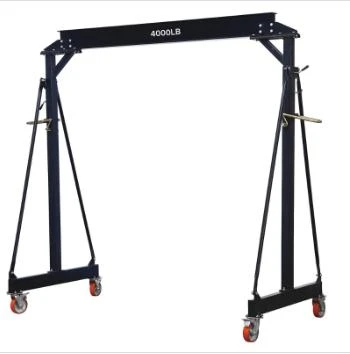fixed gantry crane
The Importance of Fixed Gantry Cranes in Modern Industry
Fixed gantry cranes are essential pieces of equipment in various industrial settings, playing a crucial role in the efficient movement of heavy materials and products. These robust cranes are designed to operate in outdoor environments, offering a range of advantages that enhance productivity and safety in workplaces.
One of the primary benefits of fixed gantry cranes is their ability to lift and transport heavy loads across significant distances. Unlike traditional cranes, which may require more operational space and can be limited by their mounting configurations, fixed gantry cranes feature a durable framework that allows them to traverse large work areas with minimal effort. This design is especially beneficial in industries such as shipping, construction, and manufacturing, where moving heavy components is a routine requirement.
Fixed gantry cranes are constructed using high-strength materials, ensuring they can withstand the rigors of heavy lifting. This construction means they offer excellent stability and safety during operations. The crane’s fixed nature limits swaying and instability, making it a reliable choice for handling loads that would otherwise be difficult or risky to manage. Safety is a top priority in any industrial operation, and the use of fixed gantry cranes significantly reduces the risk of accidents.
Versatility is another key feature of fixed gantry cranes. They can be equipped with various hoisting mechanisms and attachments, allowing them to lift different types of materials, including containers, concrete blocks, and equipment. This adaptability means that industries can invest in a multi-functional solution that meets their varied lifting needs without requiring multiple types of cranes.
fixed gantry crane

Additionally, fixed gantry cranes can be customized to cater to specific operational requirements. Companies can adjust the height and width of the cranes, as well as the lifting capacity, to ensure optimal performance. This level of customization ensures that the cranes can fit seamlessly into existing operations, maximizing efficiency and minimizing downtime during installation and use.
In terms of maintenance, fixed gantry cranes require less attention compared to other lifting solutions, as their robust design minimizes wear and tear over time. Regular inspections and maintenance routines can easily be scheduled, ensuring that the cranes remain in optimal working condition. This reliability translates to fewer operational interruptions and reduced costs associated with repair and replacement.
Environmentally, using fixed gantry cranes can also have positive impacts. These cranes are often powered by electric motors, leading to lower emissions compared to traditional diesel-powered lifting equipment. This energy efficiency contributes to a company's sustainability goals, reflecting a growing industry trend towards reducing carbon footprints.
In conclusion, fixed gantry cranes are invaluable assets in modern industrial environments. Their ability to handle heavy loads safely and efficiently, combined with their versatility and customizable features, makes them an attractive solution for many businesses. As industries continue to evolve and demand more from their equipment, the significance of fixed gantry cranes is set to increase, solidifying their place as essential tools in the heavy lifting landscape. Emphasizing safety, efficiency, and adaptability, fixed gantry cranes not only improve productivity but also contribute to the overall operational success of industrial facilities.
-
Unlock Seamless Relocation with Our Heavy Equipment Moving ExpertiseNewsJun.06,2025
-
Unleash Unrivaled Flexibility with Our Adjustable Gantry CraneNewsJun.06,2025
-
Unleash Heavy-Duty Efficiency with Our Industrial Gantry Crane SolutionsNewsJun.06,2025
-
Revolutionize Steel Handling with Our Magnetic Lifter RangeNewsJun.06,2025
-
Master Equipment Mobility with Premium Machinery Mover SolutionsNewsJun.06,2025
-
Elevate Your Material Handling with Magnetic Lifter TechnologyNewsJun.06,2025
-
YS Permanent Lifting Magnets: The Smarter Way to Handle SteelNewsMay.22,2025
